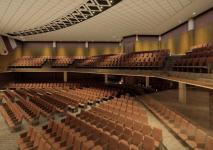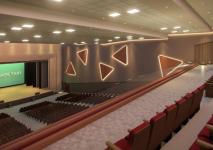Auditorium Designing
Modern Auditoriums are one of the most complex types of room environments from a designing and integrating standpoint thanks to the sheer scale of scenarios they need to be used in. The primary requirement in an auditorium is to ensure that every seat allows members of the audience to see and hear the “event”. Auditoriums can usually provide seating space between 25 to 1,000 people.
It is important to consider that most events held at this scale are usually public. Therefore, it’s crucial to ensure that the event managers and choreographers have access to powerful communication tools to control various aspects of the event. The list of solutions could include aspects such as sound reinforcement, lighting, drapes, visual displays, camera’s etc.
We have years of experience in designing and integrating communication solutions for Auditoriums of various size. We asked our team to share the top five tips for optimum auditorium design.
Visibility of the stage and the screen must be excellent and we need to ensure a clear line of sight by providing sloped floors and staggered seating. Also, ensure that the screen height (diagonal) is at least 1/6th of the distance between the screen and the last few rows. Any smaller and the visibility of the display will be compromised. We recommend using a high-resolution (Full HD or 4K) and high brightness projector (above 5,000 lumens) with a high-gain projection screen. These days you can also go for a high-resolution LED video wall with a multifunctional digital signage solution.
Mechanical systems noise control and vibration isolation is an important aspect of the auditorium environment. HVAC and mechanical noise from other systems impact room acoustics, structural vibration and exterior noise levels. Controlling the external noise is winning half the battle in achieving great sound quality. A systematic noise measurement study is needed to decide on modifications and adjustment to mitigate the impacts of these noise sources.
Audio design and engineering are some of the most important aspects of auditorium design, and one that probably has the maximum impact on the audience experience. The auditorium must be acoustically treated on the sides and ceiling. The sound system design must take into account the acoustics and noise level of the Auditorium. Many auditoriums get this wrong despite considerable investments and attention. Large venues are subject to higher reverberation time which can significantly affect the legibility of the sound. Apart from the ceiling and boundary microphones, a high-quality pro audio snake cable can aid in clean and organised cable management.
Centralised control via touch-based controllers is necessary for easy control of the system in the high-pressure environment that high-profile live events inevitably create. These control systems can be integrated with almost any electronic or electrical system including HVAC, sound systems, lighting, drapes, AV devices, projectors, screens, cameras, video conferencing systems etc.
Stage lighting is a great tool for ensuring visibility and setting the right mood and ambience. It enhances the aesthetics of the setting and is extremely crucial in live performance situations such as plays or musical events. Floodlights, wash lights, PAR cans, spotlights, moving heads, scanners, lasers come together to form your lighting system, which can be programmed and managed remotely with a digital DMX mixer.



